The Permian Basin has been the star of the U.S. shale oil and gas industry for years. But this star is, at least for the time being, dimming as production costs rise with the natural depletion of top-quality acreage. But there is another formation that could take up the torch from the Permian. And it’s in Canada.
The Montney Formation in Western Canada spans Alberta and British Columbia is one of the largest natural gas deposits on the continent. It also has some rather solid crude oil resources—and some of the lowest production costs in the industry.
“The primary benefit of Canadian oil sands and Montney assets lies in their extensive inventory of low-cost resource,” Enverus wrote in a recent analysis of the prospects of oil sands and the Montney shale. Capable of surviving at sub-$50 per barrel of WTI for longer than U.S. shale players, Enverus said, “These Canadian plays offer low-cost assets that remain economically viable over an extended period, providing a stable and attractive investment opportunity.”
Currently, the Montney shale produces some 2 million barrels of oil equivalent daily. A lot of this is gas, and even more will be gas once LNG Canada begins operation, with the launch scheduled for later this year. Yet there is oil to be pumped out of Montney, and some believe U.S. producers may start moving north to do just that.
Related: U.S. and Saudi Arabia Sign Major Energy Deals During Trump’s Visit
With the slowdown in production growth in the Permian, other shale plays will rise to prominence among oil and gas drillers, and Montney is a top candidate for such prominence, a recent report from Kimmeridge suggested. According to the energy investment firm, Montney is the top shale basin in North America with a view to future supply, sporting massive volumes of untapped resources with a high quality.
Among its other advantages, Kimmeridge lists its slower rate of exploitation as compared with the Permian, its low breakeven costs, and the fact that it is especially prolific in natural gas at a time when demand for that specific hydrocarbon is on the rise, and this rise is strong. Incidentally, Alberta’s government just froze the price of carbon emissions in order to stimulate its energy industry along with its other industries.
Kimmeridge estimates that the Montney shale has a lifespan of 22 years based on what the investment firm calls front-end inventory duration and the 2023 recycle ratio for North America. This is by far the longest lifespan of all shale basins that the firm reviewed in its report. It means that drillers in Montney will take 22 years “to drill from the highest to the lowest recycle ratio locations at the current activity pace (2023, in this case) until they start drilling below-2023-average wells.”
This is quite appealing for those E&Ps looking for long-term sustainable oil and especially gas production. The news that Alberta will keep carbon prices at C$95 per ton instead of following earlier laid out plans to gradually increase the emissions burden on the industrial sector should provide additional incentive for growth in the Montney.
Interestingly, producers already active in the Montney are currently hunkering down amid weaker gas prices. BOE Report wrote recently that licensing activity in the play has so far exceeded the rate of approvals in 2024, but fewer wells are being spudded—a lot fewer than last year. “Operators are holding off on drilling, likely waiting for commodity prices to rebound rather than burn through inventory at low prices,” the report said.
The start of LNG Canada is set to change this as it will boost natural gas prices, stimulating stronger activity. This might be a “Place your bets” moment for more North American energy producers interested in diversification with a view to long-term business sustainability.
By Irina Slav for Oilprice.com
More Top Reads From Oilprice.com

